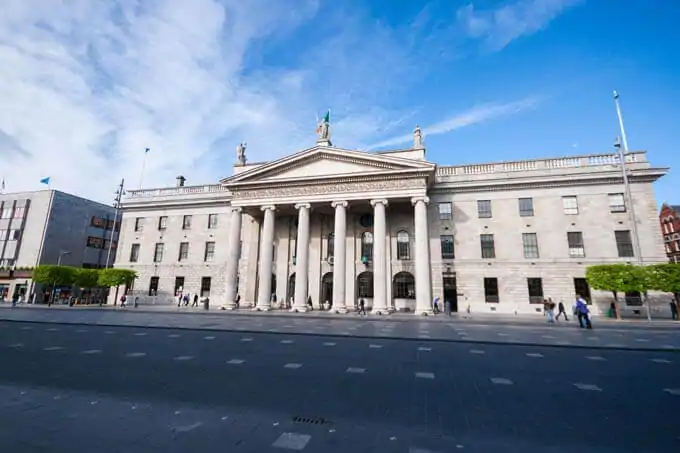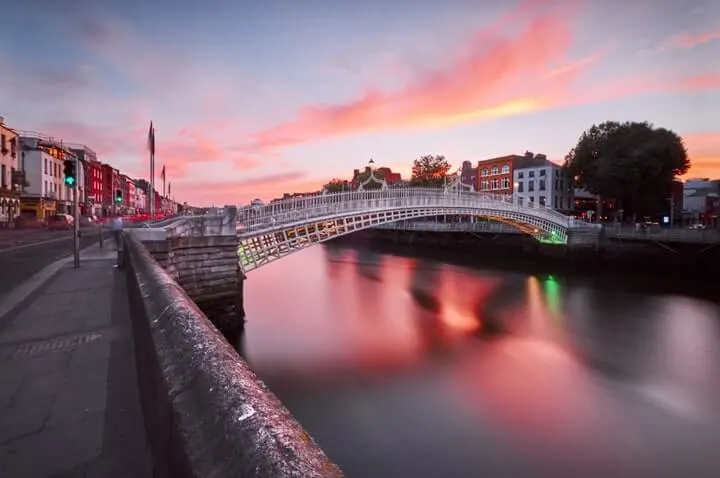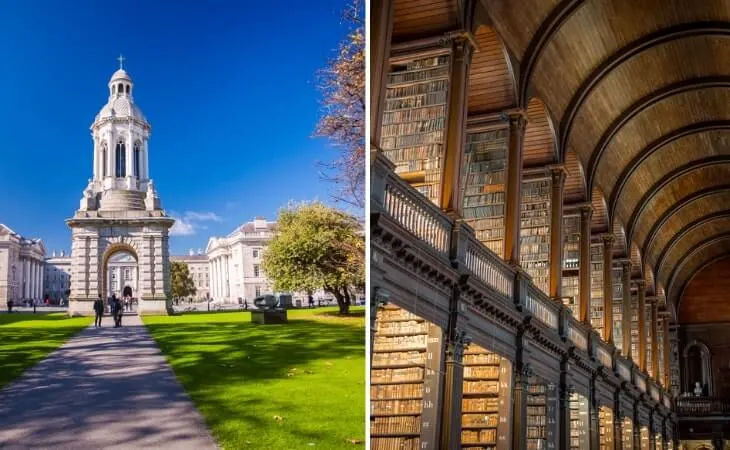You could argue that The Spire (aka the ‘Monument of Light’) is one of the best-known landmarks in Ireland.
Mainly due to the fact that it’s visible all the way from the Dublin Mountains to the skyline of Croke Park.
Standing at a whopping 121 metres tall (398 feet) and officially the world’s tallest piece of free-standing public art, The Spire is hard to miss.
In the guide below, you’ll find everything from the history of The Spire in Dublin to some stats about its construction and more.
Some quick need-to-knows about The Spire
Although a visit to The Spire in Dublin is fairly straightforward, there are a few need-to-knows that’ll make your visit that bit more enjoyable.
1. Location
Dublin’s epic sculpture, The Spire, is located on O’Connell Street Upper and it’s pretty hard to miss! It’s close to the GPO and the O’Connell Monument. It was erected on the site of the former Nelson’s Pillar.
2. What it’s all about
The Spire of Dublin was commissioned from a winning architectural design competition. It was part of the regeneration of O’Connell Street, which had been in gradual decline. Trees were removed, statues were cleaned, traffic lanes were reduced, and shop fronts were enhanced. The centrepiece of the new street layout was The Spire, completed in early 2003.
3. Height
The Spire is 121 metres tall (398 feet) and is the world’s tallest piece of free-standing public art. The upper 10-metre tip is illuminated after dark through 11,884 holes that allow beams from light-emitting diodes to shine.
4. Nicknames
The Irish love nicknames and, like all new public art installations that divide opinion, the Spire has attracted quite a number of monikers. Known officially as the ‘Monument of Light’ (An Túr Solais), The Spire is also referred to as the ‘Stiletto in the Ghetto’, the ‘Nail in the Pale’ and the ‘Stiffy by the Liffy’.
How The Spire came to be

Photo by mady70 (Shutterstock)
Standing somewhat incongruously amid grand old buildings, The Spire stands tall on O’Connell Street in the heart of Dublin City Centre. It was constructed as part of a revamp of Dublin’s main street, which had deteriorated into an array of tacky shop fronts and take-away restaurants.
Nelson’s Pillar
There was a need for a new focal point on the site where Nelson’s Pillar had stood since 1808. Known as The Stump, the Pillar was contentious as it was erected when Ireland was part of the United Kingdom, prior to the Irish War of Independence.
It was destroyed by a bomb planted by Republican Activists in 1966, leaving a bit of a hole in Dublin’s main thoroughfare.
Suggestions for a replacement included plans for a monument to Padraig Pearse, a leader of the Easter Rising, to mark his 100th birthday. The proposed £150,000 structure would have stood higher than the nearby GPO where Pearse had fought in 1916, but it never came to fruition.
Anna Livia Monument
To mark the Dublin Millennium celebrations in 1988, the Anna Livia Monument was installed on the site of the former Pillar.
Designed by Eamonn O’Doherty and commissioned by businessman Michael Smurfitt, the bronze sculpture features the reclining figure of Anna Livia Plurabelle, a character from James Joyce’s novel.
It is surrounded by water, representing the River Liffey (Abhainn na Life in Irish). And yes, the Dubliners had a nickname for this monument, too – The Floozie in the Jacuzzi!
In 2001, the Anna Livia Monument was moved to Croppies Memorial Park near Heuston Station to make way for The Spire.
Construction of Dublin’s The Spire

Photos via Shutterstock
An international design competition was launched, and the winning design was The Spire, the brainchild of Ian Ritchie Architects. It was manufactured by Radley Engineering, Waterford and erected by SIAC Construction/GDW Engineering.
The Spire was erected in six sections at a cost of €4 million. The expected completion in 2000 was delayed by a High Court case over planning permission. It was not started until December 2002 and completed on January 21, 2003.
The textured stainless steel structure shines in daylight. After dark, beams of light shine out through 11,884 holes. The Spire epitomises Dublin and is said to point towards a bright and limitless future.
Things to do near The Spire in Dublin
The Spire is a stone’s throw from some of the best places to visit in Dublin, from one of our favourite museums in Dublin to some very iconic Dublin landmarks.
Below, you’ll find places to visit a short ramble from The Spire, including the historic GPO and the quirky Ha’penny Bridge, to much more.
1. The GPO (1-minute walk)

Photo by David Soanes (Shutterstock)
Pop down O’Connell Street to the GPO building, now a fascinating museum with guided or self-guided audio tours available. It tells the story of the 1916 Easter Rising and the birth of modern Irish history that happened right here on O’Connell Street. This top Dublin attraction attracts over 100,000 visitors each year and has won numerous awards, including Best Cultural Experience (Irish Tourism).
2. The O’Connell Monument (3-minute walk)

Photo left: Balky79. Photo right: David Soanes (Shutterstock)
Further down O’Connell Street is the Daniel O’Connell statue to honour the great “Catholic Emancipator”. Sculpted by John Henry Foley, the bronze statue was unveiled in 1882. Get close and look for the bullet holes scarring the monument. They were made during the battle of the 1916 Easter Rising that took place right here.
3. Ha’penny Bridge (7-minute walk)

Photo by Bernd Meissner (Shutterstock)
Stroll along the River Liffey waterfront to the 43-metre elliptical arch bridge known as Ha’penny Bridge. Built 1816, the pedestrian bridge replaced the leaky ferry service. Users were charged a ha’penny to cross and the fee remained unchanged for a century before being abolished.
4. Trinity College (10-minute walk)

Photos via Shutterstock
Walk the hallowed grounds of Ireland’s premier university, Trinity College, in the heart of Dublin. Founded in 1592, the 47-acre campus provides a historic oasis and place of learning for over 18,000 graduate and undergraduate students. Visit the stunning Long Room and gaze at the ancient Book of Kells.
FAQs about The Spire
We’ve had a lot of questions over the years asking about everything from ‘Why was the Spire built?’ to ‘What other modern Dublin architecture is similar?’.
In the section below, we’ve popped in the most FAQs that we’ve received. If you have a question that we haven’t tackled, ask away in the comments section below.
How tall is The Spire in Dublin?
At a whopping 121 metres tall (398 feet), The Spire in Dublin is the world’s tallest piece of free-standing public art.
How much did The Spire cost to build?
The Spire was erected in six sections at a cost of €4 million. However, keep in mind that this doesn’t include maintenance and cleaning costs incurred over the years.
When was The Spire in Dublin built?
Construction on the ‘Monument of Light’ was started in December 2002. The building of The Spire was completed on January 21, 2003.
